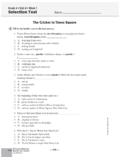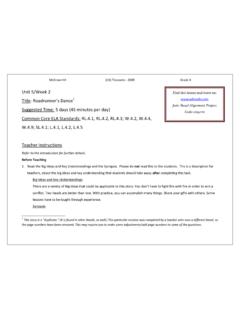Transcription of Romeo and Juliet 6 week Unit - Peter Smagorinsky
1 Romeo and Juliet 6 week unit Lynn Berry Sarah Donovan Meghann Hummel ELAN 4400 Conceptual unit December 2, 2003 Romeo and Juliet Rationale We are designing a unit based on William Shakespeare s Romeo and Juliet to introduce our overarching theme of conflict with authority. While this unit could be used in any high school setting, we are specifically designing it for our student teaching practicum in Gwinnett County. Therefore, the majority of our students will live in the suburban areas surrounding metro-Atlanta. We will be teaching students from multiple socio-economic backgrounds and cultures. This unit is created with ninth graders in mind, yet could be taught at any grade level. Tracking is a non-issue because the unit could be modified and taught to accommodate all students. The issues presented in Romeo and Juliet can be related to the lives of many adolescents.
2 As Freire (1987) says, reading the world always precedes reading the word (p. 35), and we hope to connect the students worlds to the words of Shakespeare. Although dated around the mid 1590s, the issues presented in Romeo and Juliet transcend time and place. Research completed by Erikson and Piaget shows that when learning is tied to personal or cultural interests, students are more likely to pay attention to the material because they can relate to the subject matter (Shaffer, 1994). While some people would argue that something written so long ago is outdated, issues of love, rebellion, death, and acceptance are prevalent in the lives of most students as well as the play. We plan to provide an opportunity to connect personal experiences to learning through Romeo and Juliet . The insecurities and obstacles of today s adolescents resonate with those faced by Romeo and Juliet .
3 By teaching a play relevant to current social problems, students are more willing to engage in the material. Social relevance is important because research has shown that students are more invested in learning material that they can relate too (Hull and Schultz, 2002). Issues in Romeo and Juliet transcend and connect cultures, and through teaching this we will show students that something written centuries ago can still reflect problems in today s society. One of the interests of teens is love-from frivolous to sensuous, from friendship love to romantic love (Chance, 2002, p. 139). Romeo and Juliet is often recognized as the most renowned love story ever written. Its historical and literary significance commands its presence in the majority of schools curricula. The readers of this work are widespread, and it has impacted modern writers around the world.
4 Much of what is written and said in American culture requires a basic reading and understanding of Romeo and Juliet and its language. This play is referenced in writing, the media, movies, television, and even conversation. Therefore this work not only connects with the students individual lives, but also with the culture and mass media that they are surrounded by. We have not designed this unit to force students into memorizing a play, but to discuss the issues that arise in Romeo and Juliet . Student choice is very important because options allow students to have a more active role in their education. According to Starnes and Paris (2000), the students of teachers that give them choices are more likely to buy into their education and learn. By framing our major assessment around Gardner s theory of multiple intelligences (1999), we allow students to express their knowledge in the medium through which they learn best.
5 Students may choose from performance art, visual art, and/or writing to convey their interpretation of a scene of their choice. In doing so we hope to validate all forms of expression and provide room for creativity. Just as our students will learn from us as teachers, we hope to learn from their interpretations and gain insight into their thoughts and ideas. We will allow for group and individual projects in order to meet the needs of all students. Viewing all who enter the classroom as learners and teachers, we hope to provide an environment conducive to critical inquiry and learning. This relates to Joan Wink s (2000) idea of conscientization involving a transformation of the learner and teacher as a result of interaction between the two of them (p. 43). We realize that no student comes to school an empty vessel and that all students have knowledge and experience that everyone can learn from.
6 Students and teachers should work together in their learning endeavors in order to validate everyone s contributions. We plan on implementing this idea in our unit through discussion rather than lecture based activities. The students must inquire into the historical relevance of Romeo and Juliet , William Shakespeare, and aspects of the time period. Students choose which feature they are interested in researching and serve as the expert in relaying their findings to the class. When doing this, students take on the role as teachers and learners. Many of the activities and readings will stem from and involve writings and discussions that relate Romeo and Juliet to the lived experiences of our students. Through inquiry based learning we will bridge the gap between out-of-school and classroom literacies (Hull & Schultz, 2002) in an effort to give all students voice.
7 This play is important not only because of its historical and literary relevance, but also because it connects student s social worlds with their education. According to Beach and Myers (2001) students have several different worlds: social, school, church, home, peer, etc., and schools should make a concerted effort to bring various worlds into the school environment. The bridging of these outside worlds to the school world allows students to feel more invested in the school curriculum. By encouraging the discussion of personal events related to those that occur in Romeo and Juliet we hope to allow out-of-school literacies in the classroom. Most adolescents have dealt with issues concerning conflicts with authority, and can therefore bring in various relevant perspectives from their social worlds. Through classroom activities and conversations we hope to discuss: conflicts with parents, power relations, gangs, suicide, violence, rebellion, love, death, and the development of character.
8 Although some of these issues might be controversial, we feel it is better to discuss them in a safe, school environment rather than allow them to foster outside the classroom. All of these topics can be related to social worlds through lived experience and the school world through Romeo and Juliet . According to Nieto (2002), when the curriculum is connected to students lives there are positive results. We hope to have students invested in our unit initially through personal experiences and with the end result of a positive literary occurrence. Through choice and different mediums we hope to design a unit that will benefit all students. While time consuming and challenging, this unit offers multiple ways for students to express themselves both personally and through the work. We expect them to go beyond basic plot summary and to explore aspects of Romeo and Juliet that personally interest them.
9 Their final project requires in depth knowledge of a scene of their choice, which they must either interpret through acting, drawing, rewriting, or a combination of these. We will provide scaffolding throughout the unit to prepare them for this challenging and creative assessment. Classroom discussion and activities will revolve around history, character, persuasive arguments, and different ways of interpreting works. We will provide visual stimulation through the viewing of Luhrmann s and Zeffirelli s take on the play through film. The students will compare the representation of these scenes to those of the written text. This will prepare them for developing their own original interpretation for the final. Students will also do research on computers, activities exploring character, create a Shakespeare Dictionary to understand language, participate in persuasive debates, and learn about and write their own soliloquies.
10 With such a broad range of activities, we hope to target the strengths of all of our students. Aspects of choice, relevance, and connecting literary to social meaning are all important teaching devices we incorporate into our unit . Works Cited Beach & Myers, (2001). Inquiry-Based English Instruction: Engaging Students in Life and Literature. New York: Teacher s College Press. Elliot, J., & Dupuis, M. (2002). Young Adult Literature in the Classroom: Reading it, Teaching it, Loving it (p. 139). Pennsylvania: International Reading Association. Freire, P., & Macedo D. (1987). Literacy: Reading the Word and the World. South Hadley, Maryland: Bergin & Garvey. Gardner, H. (2000). The Disciplined Mind: Beyond Facts and Standardized Tests, the K-12 Education that Every Child Deserves. New York: Penguin Group. Hull, G. & Schultz, K. (2002).






